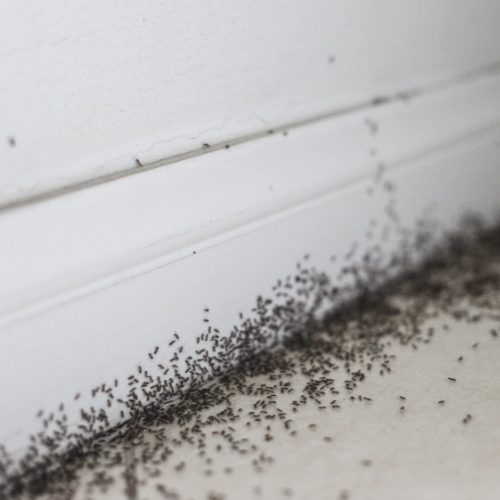
07 Feb Differentiating Between Ant Species
Identifying Different Ants Among Us
Hey there, South Florida! Ever found uninvited guests at your picnic or in your kitchen? We’re talking about ants, those tiny critters that turn our homes into theirs. It’s surprising how they sneak in, from ghost ants in your sugar to carpenter ants in the woodwork.
Ants play a crucial role in our ecosystem, like aiding decomposition and controlling pests. But when they invade our spaces, it’s time for action. Identifying them is the first step in keeping them at bay.
Let’s dive into the world of ants and spot the differences! With the right knowledge and strategies, we can manage these tiny invaders. Join us as we explore how to keep your home ant-free.
The Crafty Woodworkers
Carpenter ants are the big guys, with bodies that can stretch up to half an inch. They’re mostly black but can also flaunt dark brown or red shades. Unlike termites, they don’t eat wood but love to carve out galleries for their nests, which is why they’re often mistaken for their wood-chomping cousins.
These ants are all about the woodwork, preferring to set up camp in moist or damaged wood. They’re night owls, often foraging at night, which makes them a bit harder to catch in the act.
Though they don’t eat wood, the tunnels they create can weaken structures over time. Spotting sawdust-like material and hearing faint rustling noises in walls can be telltale signs of their presence.
Sun-Lovers with a Sting
Fire ants are easily identifiable by their aggressive behavior and painful sting. They’re smaller than carpenter ants, sporting a reddish-brown color, and they build noticeable mound nests outdoors.
These feisty critters love the sun and can often be found in open areas. Disturb their mound, and they’ll swarm out to defend their home, delivering stings that can cause allergic reactions in some people.
Beyond the immediate pain, fire ant stings can lead to serious health issues for those allergic to their venom, necessitating quick medical attention in severe cases.
Spotting the Unseen
Ghost ants are tiny and hard to spot, with translucent legs and abdomens, giving them their ghostly name. They’re about 1/16 inch long, making them one of the smaller nuisances in the ant world.
They thrive in moist environments and are often found in kitchens and bathrooms, attracted to sweet substances. Unlike some other ant species, ghost ants are highly adaptable, nesting both indoors and outdoors.
Because of their small size and preference for nesting in hard-to-reach places, ghost ants can be particularly challenging to control. Regular cleaning and sealing of food containers are key to keeping them away.
Masters of Indoor Colonization
Pharaoh ants are small, about 1/16 inch long, with a light yellow to red color, distinguished by their darker abdomens. They’re often mistaken for other ant species but are known for their love of indoor environments.
These ants prefer warm, humid areas and can often be found in hospitals, apartment buildings, and other large structures where they can easily find food and water. Pharaoh ants are notorious for their ability to establish large colonies quickly.
Pharaoh ants are more than just a nuisance; they can spread diseases by contaminating food and medical equipment. Their ability to split their colony and form new ones when threatened makes them particularly difficult to eradicate.
The Art of Ant Control
Navigating the world of ant control can sometimes feel like a tricky maze. Sure, a quick internet search can offer dozens of DIY remedies, from cinnamon barriers to coffee ground moats. While these might hold the fort temporarily, they rarely solve the queen problem (pun intended). That’s where the pros come in.
Professional pest control doesn’t just skim the surface; it dives deep. We at Pest Busterzz use targeted treatments that reach the heart of the colony, ensuring the queen and her subjects find new royal quarters far from your home. Plus, we tailor our strategies to the specific species terrorizing your peace, because treating fire ants like they’re pharaohs just won’t do.
On the flip side, DIY methods have their place, especially for immediate action. Noticed a few scouts on your counter? Wiping them away with soapy water can cut off the trail. But when the cavalry arrives, it’s time to call in the reinforcements.
The ABCs of Ant Prevention
Prevention is better than cure, they say, and it’s never truer than with ants. Keeping these tiny invaders at bay involves a mix of vigilance, hygiene, and a bit of ant psychology.
First off, keep it clean. Ants are on a perpetual hunt for food and water. Ensuring crumbs and spills are cleaned up promptly, storing food in sealed containers, and fixing leaky pipes can make your home less appealing to their foraging parties.
Next, seal entry points. Ants can find their way through the tiniest of gaps. Regularly inspecting and sealing cracks in windows, doors, and foundations can cut off their access. It’s like closing the gates before the enemy breaches the walls.
Lastly, landscape smartly. Your garden can be a paradise for ants, providing both shelter and sustenance. Keeping shrubs trimmed and mulch levels moderate can discourage ants from setting up camp close to your home.
Conclusion
Exploring the world of ants has unveiled their varied impacts on our lives, from the structural threats posed by carpenter ants to the health risks associated with fire ants. This knowledge is essential for tailoring effective ant control strategies.
Highlighting the blend of DIY solutions and the depth of professional pest control, it’s clear that a thorough approach is often needed to tackle ant infestations effectively. Pest Busterzz’s expertise shines in providing targeted, long-lasting solutions.
Preventive measures, emphasizing cleanliness and home maintenance, emerge as key in deterring these persistent pests. For South Florida residents facing ant challenges, Pest Busterzz is your ally, ready to ensure your home remains a no-ant zone.


No Comments